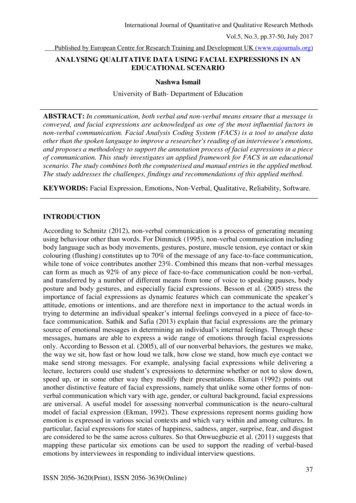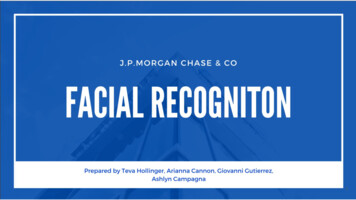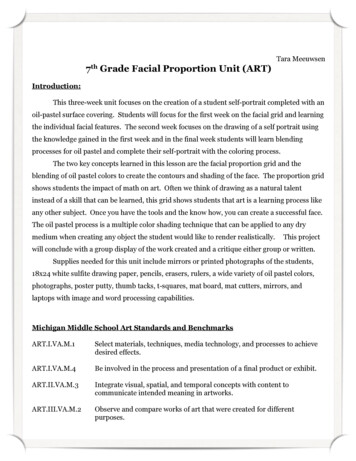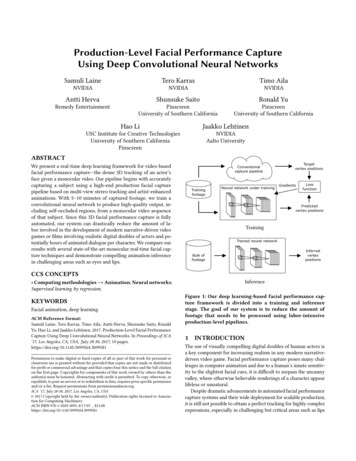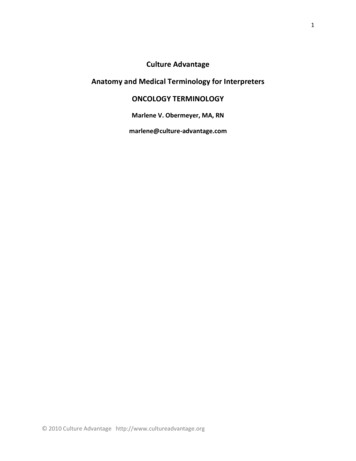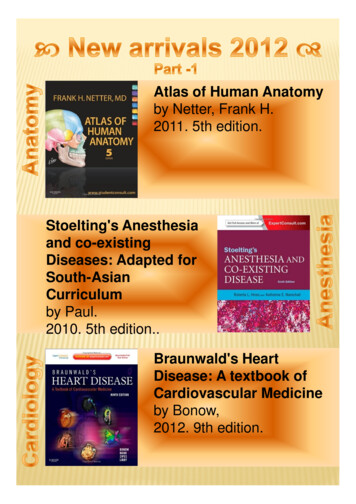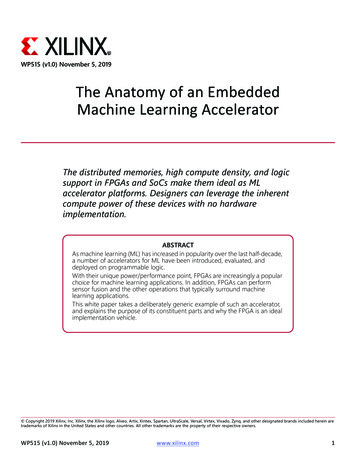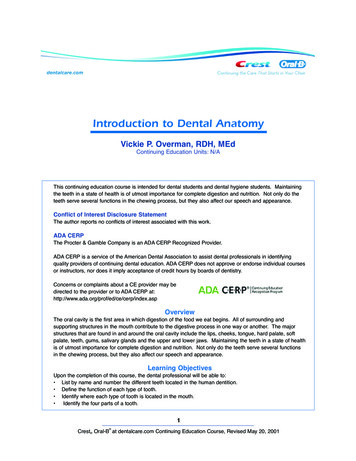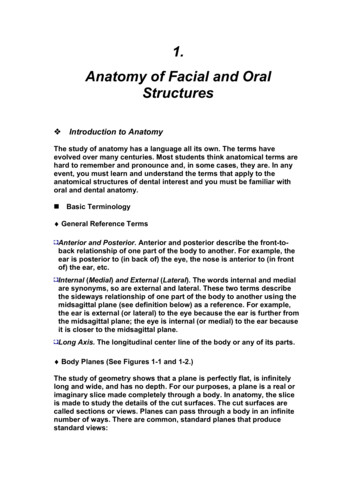
Transcription
1.Anatomy of Facial and OralStructures Introduction to AnatomyThe study of anatomy has a language all its own. The terms haveevolved over many centuries. Most students think anatomical terms arehard to remember and pronounce and, in some cases, they are. In anyevent, you must learn and understand the terms that apply to theanatomical structures of dental interest and you must be familiar withoral and dental anatomy. Basic Terminology General Reference TermsAnterior and Posterior. Anterior and posterior describe the front-toback relationship of one part of the body to another. For example, theear is posterior to (in back of) the eye, the nose is anterior to (in frontof) the ear, etc.Internal (Medial) and External (Lateral). The words internal and medialare synonyms, so are external and lateral. These two terms describethe sideways relationship of one part of the body to another using themidsagittal plane (see definition below) as a reference. For example,the ear is external (or lateral) to the eye because the ear is further fromthe midsagittal plane; the eye is internal (or medial) to the ear becauseit is closer to the midsagittal plane.Long Axis. The longitudinal center line of the body or any of its parts. Body Planes (See Figures 1-1 and 1-2.)The study of geometry shows that a plane is perfectly flat, is infinitelylong and wide, and has no depth. For our purposes, a plane is a real orimaginary slice made completely through a body. In anatomy, the sliceis made to study the details of the cut surfaces. The cut surfaces arecalled sections or views. Planes can pass through a body in an infinitenumber of ways. There are common, standard planes that producestandard views:
Sagittal Plane. A planethat parallels the longaxis and divides a bodyinto right and left parts. Amidsagittal plane dividesbodies into equal rightand left sides.Frontal Plane. A planethat parallels the longaxis and divides a bodyinto anterior andposterior parts.Transverse (Horizontal)Figure 1-1. Sagittal and FrontalPlane. A plane thatPlanesdivides a body into upperand lower parts. Morespecifically, it is a slicethat passes through abody at right angles (90degrees) to the sagittaland frontal planes.Figure 1-2. TranversePlanes Anatomical TerminologySince anatomy is a descriptive science, a good deal of theeffort involved in learning it is associated withmemorizing terms. However, as more knowledge isacquired in this specialty through association, structuresand their functions are easily recalled. Nevertheless at theoutset, description of structures is generally rememberedthrough a process of memorization. Bear in mind thatrelating the function of a structure to its morphology as
well as to other structures is the basis for an in-depthretention of anatomy.While anatomical structure, some years ago, wasdescribed in Latin, in most cases (although there areexceptions) this terminology has given way to ananglicized version of the Latin. Other problems inanatomical terminology relate to the fact that frequently astructure may have several names. In fact in the latter partof the nineteenth century, estimates show that there weresome 50,000 terms in use but these only related to some5,000 structures, for an average of 10 names perstructure! Various systems have been developed andreviewed for a structured arrangement for naming inanatomy. In the 1950’s and 1960’s, the Nomina Anatomicawas developed in Paris on which all official terminology isbased.Anatomical terminology can be divided into 2 types:terms that refer to components of the body and terms thatrefer to direction, e.g., proximal or distal.Body ComponentsHead - caput, skull - craniumNeck - collum or more commonly cervicalTrunk - 4 regions: dorsum (back), thorax (chest),abdomen, pelvis.Limbs - shoulder, arm, forearm, hand; hip, thigh, leg, foot.Terms of PositionThese terms are really the most complex. All referencesto position refer to the living body standing in what istermed the anatomic position. This is defined as: standingerect with the palms facing forward, feet straight ahead.To this basic position all anatomic terms of direction arereferred.Anterior/posterior - in man these terms are synonymouswith ventral/dorsal. However, in 4- legged animals theyare not. Anterior refers to toward the front of the bodywhile posterior refers to toward the back.Superior/inferior - synonymous with cranial or caudal.Superior refers to toward the head while inferior refers to
the opposite direction.Proximal/distal - refers to "closer to" or "further from."PlanesSagittal - is a plane passing through the body from thefront to the back. Thus the body is divided into 2 halves.Note that the body does not have to be divided into 2equal portions unless divided by a midsagittal plane.Coronal - divides the body by a plane passing at rightangles to the sagittal plane. Note that both sagittal andcoronal also refer to sutures in the skull which pass in thecorresponding direction.Transverse - a horizontal plane through the body.In addition to these general descriptive terms we alsoemploy terms of movement.Flexion/extension - these specify movement in muscles ata joint in the opposite directions. Flexion indicates amovement which decreases the angle between two boneswhile extension indicates a movement that increases theangle. For example, in the anatomic position (i.e., with thepalms of the hands facing forward) muscles which causemovement at the elbow such that the forearm bendsupward toward the arm are considered "flexors" of theforearm or of the elbow. On the contrary, muscles whichcause the forearm to move away from the arm are termedextensors.Abduction/adduction - refer to the movement away fromor towards the median plane (a midsagittal plane)respectively.Protraction/retraction - refer to an anterior movement orposterior movement respectively. Used with movementsof the mandible.Rotation - refers to the movement of a body part about itslongitudinal axis. Bony ElevationsTubercle, Eminence, or Tuberosity. All of these words describe rathersmall, somewhat circular areas that are raised above the general levelof the surrounding bone. An elevation of bone that falls in this
category was specifically labeled as an eminence, a tuberosity, or atubercle by the person who originally described it. There might be littleto distinguish among these kinds of elevations as far as relative shapeand size are concerned. They just have to be memorized according tothe names they carry.Ridge. A linear elevation on the surface of a bone.Process. A very prominent projection from the central mass of a bone.Condyle. A rounded, convex, smooth surface on one of the bones thatforms a movable joint. Bone Depressions and ChannelsFovea. A shallow, cup-shaped depression or pit.Fossa. A more or less longitudinal, rounded depression in the surfaceof a bone.Canal. A tubular channel through bone. The channel has at least oneentrance and one exit hole. A canal’s entrance or exit hole is called aforamen. JointsJoints can be classified in a number of ways, one of the ways being thekind of movement that the structure of the joint allows. There are threekinds of joints found in the human skull.Synarthrosis or Immovable Joint. Most bones of the skull are joinedtogether along highly irregular, jigsaw puzzle-like lines called sutures.A suture joint is classified as a synarthrosis. Bones joined alongsuture lines in the skull are not totally immobile. Movement occurs, butit is very limited.Ginglymodiarthrodial Joint. Literally defined, this is a freely movable,gliding, hinge joint. This relationship of one bone to another allows thegreatest range of movement of any joint type. The termginglymodiarthrodial specifically describes the temporomandibularjoint that unites the lower jaw with the rest of the skull.Ellipsoidal Joint. The type of joint that exists between the occipitalbone of the skull and the first vertebra of the spinal column. There aretwo axes of motion at right angles to each other in this joint, and bothaxes pass through the same bone. This arrangement enables you tonod your head and rotate it from side-to-side. MusclesThe mass of a muscle is composed of many individual cells that arecapable of contracting. The force generated by the muscle as a whole
depends on how many cells in the muscle’s mass are contracting at anygiven time. Muscles can pull (contract or shorten); they cannot push. Arelaxed muscle cannot get any longer unless another contractingmuscle somewhere else is forcing the extension. It should be obviousthat a simple act like flexing and extending a finger requires at least twodifferent muscles. The muscles used in flexing and extending a fingerperform actions that are opposite one another. The performance of anaction by one muscle that is opposed to the action of another is calledantagonism. Besides having definite names, muscles are described interms of:Origin. A structure where a muscle attaches that moves the least whena muscle contracts.Insertion. A structure where a muscle attaches that has the greatermovement during contraction.Action. The performance expected when a particular muscle contracts. Bony Anatomy of the Head OverviewThe skull is that portion of the human skeleton which makes up thebony frame work of the head. For descriptive purposes, the skull isdivided into an upper, dome-shaped, cranial portion; and a lower orfacial portion composed of the eye sockets, nasal cavities, and bothjaws. The adult skull is composed of 22 bones (8 cranial and 14 facial)(Figure 1-3). Cranial Bones. The 8 bones of the cranium are:FrontalParietal (right and left)OccipitalTemporal (right and left)SphenoidEthmoidNOTE: The shape and arrangement of these 8 bones form a bony shell(cranium) that has a central cavity containing the brain. The arched roofof the cranial cavity is called the vault and the floor of the cavity iscalled the base.
Facial Bones. There are 14 bones in the facial portion of the r conchaVomerMandibleNOTE: There is only one vomer and one mandible in a skull: the otherfacial bones are paired. Cranial and Facial Bones of Primary Interest in Prosthetic DentistryArtificial replacements for missing natural teeth (dental prostheses)must be made to fit jaw contours and work in harmony with muscleactivity. Therefore, we will discuss only those facial bones which give
shape to soft tissues within the mouth, serve as anchorage sites formuscles which move the lower jaw, and give shape to the lower one-halfof the face. Cranial Bones of Primary InterestFrontalParietalTemporalSphenoid Facial Bones of Primary InterestMaxillaPalatineZygomaticMandible
Particular features of these bones are important to remember forsubsequent reference in this publication and indeed, for the remainderof your technical career. Particular Features of Cranial and Facial Bones Frontal BoneThe frontal bone is a single bone that forms the anterior of the cranialvault, the roof of the eye sockets, and a small portion of the nasal cavity.A temporal line can be found on both lateral surfaces of the frontalbone. The line begins in the region of the eye socket and proceedsposteriorly, often dividing into superior and inferior temporal lines nearthe posterior border of the frontal bone (Figure 1-4).
Parietal BonesThe paired parietal bones are located between the occipital and frontalbones to form the largest portion of the top and sides of the cranium.The parietal bones are marked by two semicircular bony ridges, thesuperior and inferior temporal lines, which are the posteriorcontinuation of the frontal bone’s temporal line. The superior andinferior temporal lines rim the area of origin of the temporal muscle(Figure 1-4). Temporal BonesTemporal bones are the paired bones which form a portion of the rightand left sides of the skull below the parietal bones. The temporal bonesextend down onto the under surface of the cranium and contribute tothe formation of the cranial base. Each temporal bone articulates withthe parietal above, the sphenoid in front, and the occipital bone behind(Figures 1-4 and 1-5).The significant features of the temporal bone are: Mastoid process Styloid process Zygomatic process
Glenoid fossa Articular eminence Auditory canal or external auditory meatus The convex posterior part of the temporal bone (mastoid portion)is characterized by a rounded, downward projecting mastoidprocess. The mastoid process presents a roughened exteriorsurface for attaching several muscles of the neck. The styloid process is a slender, tapering spur of bone projectingdownward from the under surface of the temporal bone. Thestyloid process has sites of attachment for multiple muscles andligaments which then go to the mandible, the hyoid bone, thethroat, and the tongue. The zygomatic process is a projection from the approximatecenter of each temporal bone which extends forward to form apart of the zygomatic arch or cheek bone. This arch or so-calledcheek bone is not one continuous bone, but is made up of anumber of parts. The zygomatic process of the temporal boneforms the posterior part. The glenoid fossa is a deep hollow on the under surface of thebase of the zygomatic process. The base of the zygomaticprocess is the place where the process originates from thecentral mass of the temporal bone. The articular eminence is a ramp-shaped prominence whichextends forward and downward from the anterior boundary of theglenoid fossa. The auditory canal or external auditory meatus is a hole in thebone found posterior to the glenoid fossa. It leads from theoutside surface of the base of the zygomatic process to the innerportions of the ear. Sphenoid BoneThe sphenoid bone resembles a bat with wings extended. It consists ofa central portion or body which is situated in the middle of the base ofthe skull and three pairs of processes: two laterally extended greaterwings, two downward
Anatomy of Facial and Oral Structures . In any event, you must learn and understand the terms that apply to the anatomical structures of dental interest and you must be familiar with oral and dental anatomy. Basic Terminology General Reference Terms Anterior and Posterior. Anterior and posterior describe the front-to-back relationship of one part of the body to another. For example, the ear .File Size: 6MBPage Count: 94

